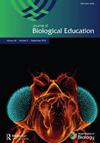是时候把孟德尔从学校课程中剔除了吗?
IF 1.4
4区 教育学
Q3 BIOLOGY
引用次数: 1
摘要
从我记事起,孟德尔就一直是中学遗传学的核心。我在学校教了40年生物学,我们受到鼓舞,并期望从孟德尔的豌豆研究开始。这很有道理。毕竟,在英国,教科书是如何介绍14-16遗传学的,规范总是从哪里开始的。简单一点:一个具有两个等位基因的单一基因,其中一个是显性的,决定了一个单一的性状。每次都是精确的3:1。16岁以后,我们介绍了双杂交,性连锁,可能还有常染色体连锁。只有一个问题。在现代遗传学的现实世界中,大多数都不是真的。自然界中很少有这样的行为,但这是战前的教导,至今仍未改变。诚然,现代普通中等教育证书的规范包括DNA、蛋白质合成和基因工程,A级生物学已经取得了进展,但基础知识没有进步。当我教孟德尔遗传学这么多年的时候。我觉得我教的是数理逻辑,而不是生物学。学生们喜欢解决问题,因为他们能很快理解原理并将其应用到新颖的例子中。当考试时间到来时,他们会得到满分,因为所有的问题基本上都是一样的。算出配子,画一个Punnett正方形,你就有答案了。那么,为什么我和过去15年里的其他人一样(Dougherty 2009;Radick 2023;Winterbottom 2016),如果孟德尔主义能保证我的学生考试成功,那么我决心看到它被废除呢?首先,大多数生物的大多数特征不是由单个基因控制的,而是多基因的,许多基因具有联合作用。一些基因是多效性的,许多是多等位基因。因此,我觉得我们所教的虽然不是谎言,但从更大的角度来看,却是一个相当独特的例子。为什么要这样教?拉迪克认为,正是贝特森以孟德尔的名义,希望生物学和社会围绕着遗传就是命运的认识进行重组。因此,更重要的是,教授孟德尔主义鼓励了公众对遗传学的一些相当危险的态度。大多数人在16岁后不学习生物学,所以他们永远看不到大局。他们开始相信“每个角色都有一个基因”,这个概念经常出现在媒体上,而环境几乎没有起到任何作用。我相信这也鼓励人们接受“基因决定论”,这一想法最初由韦斯曼提出,后来由弗朗西斯·加尔顿在20世纪初流行起来。这表明你的命运在受孕时就注定了,你的未来不在你手中,而只是由你的基因决定。这是一个非常危险的概念,应该让青少年觉得自己不是基因组的奴隶,人类是道德上负责任的代理人。当然,高尔顿也与“天生与后天”一词联系在一起,这意味着两者在某种程度上相互竞争。事实上,基因型和环境都有助于许多性状的表型,所以我建议一个更好的短语是“天生与后天”。所有的老师在职业生涯中都会遇到一对“同卵”双胞胎(我想我教过至少10对),所以在与青少年讨论双胞胎研究时,这是一个有用的工具,人们应该避免说“单卵双胞胎有多相似不是很了不起吗”,而是“考虑到他们有相同的基因,他们有多不同不是很了不起”。这就说明了环境(养育)的微小变化在表型确定中的重要性。《生物教育杂志2023》,第57卷,第4期,707–708https://doi.org/10.1080/00219266.2023.2243690本文章由计算机程序翻译,如有差异,请以英文原文为准。
Is it time to remove Mendel from the school curriculum?
Gregor Mendel has been at the heart of secondary school genetics for as long as I can remember. I taught Biology in schools for 40 years and we were encouraged and expected to begin with Mendel’s work on peas. It made sense. After all, in the UK it’s how textbooks introduce 14–16 genetics and where the specifications always started. Keep it simple: a single gene with two alleles, one of which was dominant, determining a single character. A nice exact 3:1 ratio every time. Post-16, we introduce dihybrid crosses, sex linkage and maybe autosomal linkage. There’s just one problem. Most of it just isn’t true in the real world of modern genetics. Little in nature behaves like that but it’s what was taught pre-war and it still hasn’t changed. Admittedly, modern GCSE specifications include references to DNA, protein synthesis and genetic engineering and A-level Biology has made progress, but the basics have not moved on. When I taught Mendelian genetics for all those years. I felt I was teaching mathematical logic rather than Biology. The pupils enjoyed solving problems because they could quickly understand the principles and apply them to novel examples. When exam time came round, they would get full marks because all the questions were basically the same. Work out the gametes, draw a Punnett square and there’s your answer. So why am I, like others over the past 15 years (Dougherty 2009; Radick 2023; Winterbottom 2016) so determined to see Mendelism removed if it’s guaranteeing examination success for my students? Firstly, most characters in the majority of organisms are not controlled by single genes but rather are polygenic, with many genes having a combined effect. Some genes are pleiotropic and many are multiallelic. I therefore feel that what we are teaching, while not a lie, is a rather peculiar example from a much bigger picture. Why is it taught like this? Radick believes that it was Bateson, who, in Mendel’s name, wanted biology and society reorganised around the recognition that heredity is destiny. Therefore, and more importantly, teaching Mendelism encourages some quite dangerous attitudes to genetics by the public. Most do not study Biology post-16, so they never get to see the bigger picture. They come to believe that ‘there’s a gene for’ every character, a concept that frequently appears in the press, and that environment plays little or no role. I believe it also encourages an acceptance of ‘Genetic Determinism”, an idea first proposed by Weissman and later made popular by Francis Galton in the early 20 century. It suggests that your fate is sealed at conception and your future is not in your hands but is simply determined by your genes. This is a very dangerous concept to be introducing to teenagers who should be allowed to feel that they are not slaves to their genomes and that humans are morally responsible agents. Galton, of course, is also associated with the term ‘nature versus nurture’ which implies that the two are somehow competing against each other. In reality, both genotype and environment contribute to the phenotype of so many characters so I suggest a better phrase would be ‘nature alongside nurture’. All teachers encounter pairs of ‘identical’ twins in their careers (I think I taught at least 10 pairs), so when discussing Twin Studies with teenagers, a useful tool in this topic, one should avoid saying things such as ‘isn’t it remarkable how similar monozygotic twins are’ but rather ‘isn’t it remarkable how different they are, considering they share the same genes’. This drives home the importance of minor changes in environment (nurture) in the determination of phenotypes. JOURNAL OF BIOLOGICAL EDUCATION 2023, VOL. 57, NO. 4, 707–708 https://doi.org/10.1080/00219266.2023.2243690
求助全文
通过发布文献求助,成功后即可免费获取论文全文。
去求助
来源期刊
CiteScore
3.00
自引率
27.30%
发文量
68
审稿时长
>12 weeks
期刊介绍:
Journal of Biological Education is firmly established as the authoritative voice in the world of biological education.
The journal aims to bridge the gap between research and practice, providing information, ideas and opinion, in addition to critical examinations of advances in biology research and teaching. Through the coverage of policy and curriculum developments, the latest results of research into the teaching, learning and assessment of biology are brought to the fore.
Special emphasis is placed on research relevant to educational practice, guided by educational realities in systems, schools, colleges and universities. Papers that are theoretically informed and methodologically rigorous are welcomed.

 求助内容:
求助内容: 应助结果提醒方式:
应助结果提醒方式:


